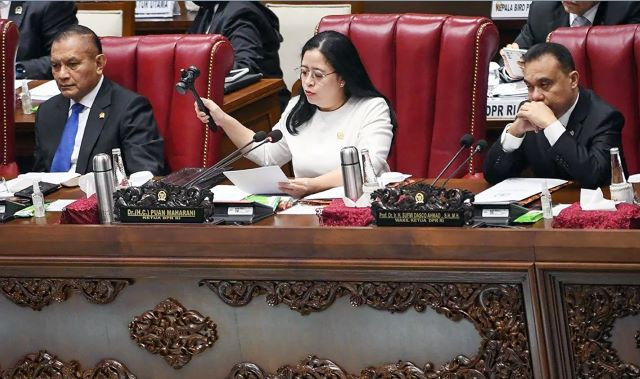Threat to debt sustainability
It is estimated that Indonesia's interest payments on debt will reach a whopping 20 percent this year, and considering that the country borrowed heavily during the pandemic and its deficit only returned to below the 3 percent legal cap last year, higher is not necessarily better when it comes to prudent fiscal management.
Change Size
 House of Representatives Speaker Puan Maharani (center) strikes a gavel during a plenary session on Sept. 21, 2023 to finalize the legislature’s approval of the 2024 draft state budget. (Antara/Aditya Pradana Putra)
House of Representatives Speaker Puan Maharani (center) strikes a gavel during a plenary session on Sept. 21, 2023 to finalize the legislature’s approval of the 2024 draft state budget. (Antara/Aditya Pradana Putra)
W
hile neither the International Monetary Fund (IMF) nor the World Bank prescribes a universal cap for the budget deficit or government debt for prudent fiscal management, Indonesia’s thresholds for prudent fiscal management, as stipulated in the 2003 State Finance Law, were based partly on advice from the two multilateral development institutions.
After all, the country was at that time still under a special macroeconomic review by the two organizations.
The law sets a fiscal deficit ceiling of 3 percent and caps government debt at 60 percent of gross domestic product (GDP), taking into account Indonesia’s economic condition and structure, debt dynamics, policy objectives and growth prospects to avoid excessive borrowing and debt accumulation.
We are therefore worried by an idea Prabowo Subianto has frequently asserted over the last few weeks that his administration, if he is sworn in as president on Oct. 20, will consider raising these thresholds to propel higher economic growth and expand the government’s social safety net programs.
Even though the proposed 2025 state budget currently being drafted by President Joko “Jokowi” Widodo and Finance Minister Sri Mulyani Indrawati will, by and large, still abide by the 2003 thresholds, Prabowo’s plan to significantly raise both the budget deficit and government debt caps would roil the market.
The blunt fact is that the government’s present debt burdens are already on the brink of being unsustainable, due to its astronomical borrowings in 2020-2022 to cope with the devastating impacts of the COVID-19 pandemic. The impacts were so severe that the economy contracted 2.17 percent in 2020 and grew only 3.7 percent in 2021, much lower than the average growth of 5 percent maintained over the last decade.
The latest official data show that government debt reached a cumulative amount of Rp 8.5 quadrillion (US$548 billion) in January 2024 from Rp 5.2 quadrillion in early 2020: an increase in the debt ratio to 39 percent of GDP from a pre-pandemic level of 30 percent in 2019.
The total debt does not include the government’s contingent liabilities to guarantee the debts of state-owned enterprises (SOEs) in the event of a payment or a project default, especially as regards infrastructure projects.
The Center of Reform on Economics (CORE) Indonesia estimates that interest payments on debt will reach 20 percent of total tax revenue this year, double the IMF’s recommended threshold of 10 percent.
The government’s debt service burden (interest payments and debt repayments) have increased from 25 percent of total tax revenue in 2015 to an estimated 47.5 percent in 2022, above the IMF’s 35 percent recommended threshold.
President Jokowi has often stated that the fiscal deficit is being managed well so it remains below the legal cap of 3 percent.
Indeed, Indonesia’s debt is still less than 40 percent of its GDP, compared to around 60 percent in other major ASEAN countries such as Malaysia, Thailand and the Philippines.
The problem, however, is that Indonesia’s tax revenue as a percentage of GDP (tax ratio) is only around 10 percent. This has left the state budget’s primary balance in a constant deficit.
The primary balance is the difference between the revenues the government collects and the amount it spends on the provision of public goods and services, excluding debt service payments.
The tax ratio for Malaysia is 12 percent, Thailand 16 percent and Vietnam and the Philippines 18 percent each. Meanwhile, the tax ratio of developed countries in the OECD is 34 percent.
Even with a fiscal deficit target of just 2.3 percent, interest payments on debt alone (excluding debt repayments) are expected to reach 20 percent of tax revenue this year.
If the deficit ceiling is raised above 3 percent – keeping in mind that 20 percent of the state budget is reserved for 12-year mandatory education – how much fiscal space will then be available for other expenditures, such as salaries for government employees, public health programs, social assistance, regional budgets and infrastructure spending?









